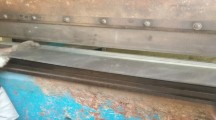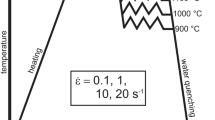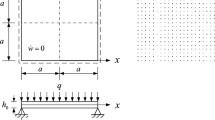Abstract
This paper proposes a Q* parameter to analyze the creep crack growth rate (CCGR) for modified 9Cr-1Mo steel. A C* parameter is not reasonable for some practical applications because it has a dual value in the early stage, although the CCGR has been generally evaluated by the C* parameter. The Q* parameter is able to evaluate the CCGR by a simple monotical linear function without a dual value due to the “nose” in the early stage of the CCG curve. The K, C*, and Q* parameters have been used to analyze the CCGR for this steel, and the scattered data among the three parameters were obtained and compared. In the scattered data from the early stage to the acceleration stage, the Q* parameter was found to be superior to the C* parameter, while the K parameter had the largest scatter and there was no systematic trend among each series of tests. It is obvious that the Q* was regarded as an independent parameter, whereas the C* was regarded as a dependent parameter that depends on the creep deformation rate, which is a function of applied load, temperature, specimen shape, and activation energy of deformation, etc.
Similar content being viewed by others
References
W. G. Kim, J. Y. Park, S. D. Hong and S. J. Kim, Probabilistic assessment of creep crack growth rate for Gr.91 steel, Nucl. Eng and Design, 241 (2011) 3580–3586.
W. G. Kim, S. H. Kim and W. S. Ryu, Evaluation of Monkman-Grant parameters for type 316LN and modified 9Cr-Mo stainless steels, J. of Mechanical Science and Technology, 16 (2002) 1420–1427.
W. G. Kim, S. H. Kim and C. B. Lee, Long-term creep characterization of Gr.91 steel by modified creep constitutive equations. J. of Metals and Materials, 17 (2011) 497–504.
A. T. Yokobori, Jr., T. Yokobori, T. Nishihara and T. Yamaoka, An alternative correlating parameter for creep crack growth rate and its application, Materials at High Temperatures, 10 (1992) 108–118.
Y. Kaji, K. Kikuchi and A. T. Yokobori, Jr., Estimation of creep fracture life for hastelloy XR by Q* parameter, Eng. Fract. Mech., 50 (1995) 519–528.
A. T. Yokobori, Jr. and T. Yokobori, Comparative study on characterization parameters for high temperature creep crack growth with special emphasis on dual value behaviour of crack growth rate, Eng. Fract. Mech., 55 (1996) 493–503.
ASTM E 139-07, Standard test method for conducting creep, Creep rupture and stress rupture tests of metallic materials (2007).
ASTM E 1457-07, Standard test method for measurement of Creep crack growth rates in metals (2007).
T. Yokobori, H. Sakata and A. T. Yokobori, Jr., A new parameter for prediction of creep crack growth rate at high temperature, Eng. Fract. Mech., 13 (1979) 533–539.
A. T. Yokobori, Jr., H. Tomizawa, H. Sakata, T. Kako and T. Kuriyama, Representation of the displacement rate between the loading points in terms of applied stress and temperature and its relation to creep crack growth rate, C*, P and Q* parameters, Eng. Fract. Mech, 28 (1987) 805–816.
T. Yokobori, C. Tanaka, K. Yagi, M. Kitagawa, A. Fuji, A. T. Yokobori, Jr. and M. Tabuchi, Result of an intercomparison of creep crack growth tests made in Japan, Materials at High Temperatures, 10 (1992) 97–107.
A. T. Yokobori, Jr., T. Yokobori and T. Nishihara, Characterization of high temperature creep crack growth and creep life from high temperature ductile through to high temperature brittle materials, Eng. Fract. Mech, 40 (1991) 737–748.
A. T. Yokobori, Jr., T. Yokobori, T. Kuriyama, T. Kako and T. Kaji, Proc. Int. Conf. Creep, JSME, IME, ASME, ASTM, 135 (1986).
A. T. Yokobori, Jr., T. Uesugi, T. Yokobori, A. Fuji, M. Kitagawa, I. Yamaya, M. Tabuchi and K. Yagi, Estimation of creep crack growth rate in IN-100 based on the Q* parameter concept, J. of Material Science, 33 (1998) 1555–1562.
W. G. Kim, S. N. Yin, J. Y. Park, S. D. Hong and Y. W. Kim, An improvement methodology for determining tensile design strengths of Alloy 617, J. of Mechanical Science and Technology, 26 (2012) 379–387.
Author information
Authors and Affiliations
Corresponding author
Additional information
Recommended by Editor Jai Hak Park
I Made Wicaksana Ekaputra is a Ph.D candidate in the Dept. of Mechanical Design Engineering of Pukyong National University. He received the B.A. from Diponegoro University, Indonesia, in 2008 and M. Engineering from Pukyong National University, Korea, in 2013. His main research interest is the creep and creep crack growth behaviors at elevated temperature.
Rights and permissions
About this article
Cite this article
Ekaputra, I.M.W., Kim, WG., Park, JY. et al. Analysis of the creep crack growth rate for modified 9Cr-1Mo steel using Q* parameter. J MECH SCI TECHNOL 28, 4075–4081 (2014). https://doi.org/10.1007/s12206-014-0920-x
Received:
Revised:
Accepted:
Published:
Issue Date:
DOI: https://doi.org/10.1007/s12206-014-0920-x




